The cells in this product are expected to be viable and may grow in culture, but it's important to note that the product is not intended for culture use. The material is not handled aseptically during manufacturing, so it is likely that other organisms would be present. The main purpose of this product is to serve as a biomass, specifically for the extraction of biomolecules such as DNA and lipids. It's important to understand that there is no guarantee of viability or purity. If the end user wishes to reconstitute the product for culture, they should add 0.3 to 0.4 ml of suitable liquid medium/broth to the freeze-dried material and mix it well. Then, they should transfer the total mixture to a culture tube or plate containing 5 - 6 mL medium/broth. It's worth noting that there is no cell count estimate available for this product.
EC11303
Escherichia coli
Strain B, lyophilized cells
Sinónimos:
E. coli
Seleccione un Tamaño
$415.00
Fecha estimada de envío12 de mayo de 2025DesdeMILWAUKEE
Seleccione un Tamaño
About This Item
$415.00
Fecha estimada de envío12 de mayo de 2025DesdeMILWAUKEE
Productos recomendados
Nivel de calidad
esterilidad
non-sterile (not processed or packaged aseptically)
Formulario
lyophilized cells
idoneidad
not intended for starter culture
temp. de almacenamiento
−20°C
¿Está buscando productos similares? Visita Guía de comparación de productos
Categorías relacionadas
Descripción general
Código de clase de almacenamiento
11 - Combustible Solids
Clase de riesgo para el agua (WGK)
WGK 3
Punto de inflamabilidad (°F)
Not applicable
Punto de inflamabilidad (°C)
Not applicable
Equipo de protección personal
Eyeshields, Gloves, type N95 (US)
Elija entre una de las versiones más recientes:
Certificados de análisis (COA)
¿No ve la versión correcta?
Si necesita una versión concreta, puede buscar un certificado específico por el número de lote.
¿Ya tiene este producto?
Encuentre la documentación para los productos que ha comprado recientemente en la Biblioteca de documentos.
-
Could you provide the reconstitution method and concentration for product EC11303 under the brand SIGMA?
1 answer-
Helpful?
-
-
What is the method of reconstitution for this product and what is the concentration?
1 answer-
These cells are expected to be viable and may grow in culture. However, the product is not intended for culture use. The material is not handled aseptically during manufacturing, therefore other organisms would likely be present. The product is intended to serve as a biomass, i.e., for the extraction of biomolecules such as DNA and lipids. There is no guarantee of viability or purity. Should the end user wish to reconstitute the product for culture, add to the freeze-dried material 0.3 to 0.4 ml of suitable liquid medium/broth and mix well. Transfer the total mixture to a culture tube or plate containing 5 - 6 mL medium/broth. There is no cell count estimate available.
Helpful?
-
Active Filters
Nuestro equipo de científicos tiene experiencia en todas las áreas de investigación: Ciencias de la vida, Ciencia de los materiales, Síntesis química, Cromatografía, Analítica y muchas otras.
Póngase en contacto con el Servicio técnico







